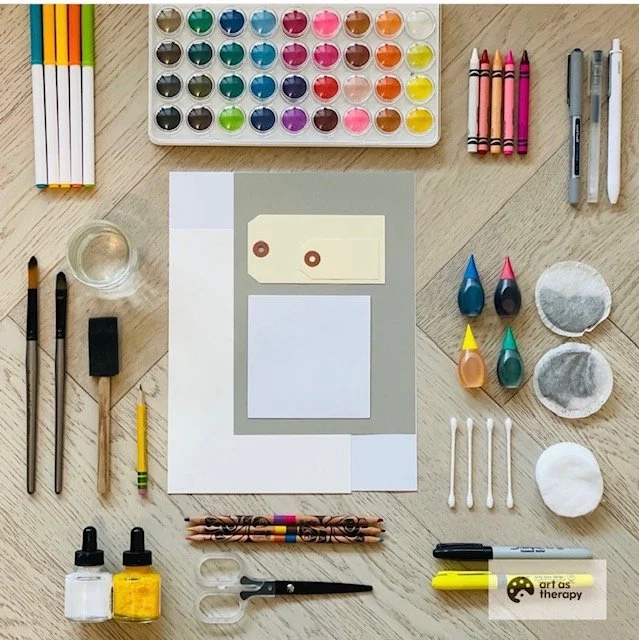Virtual Sessions: Accessible and Impactful Therapy
Preparing for Virtual Talk and or Art Therapy Sessions
Engaging in online therapy especially art therapy, can feel different from an in-person session, but we want to reassure you that virtual sessions are just as impactful as face-to-face interactions. With some intentional planning, the therapeutic experience can reflect the benefits of in-person sessions. Here are some ideas on how you can create a comfortable and effective therapeutic space at home.
Find a Quiet Space
The therapeutic space is an essential part of every session. At Art as Therapy, we ensure our in person spaces are aesthetically pleasing, welcoming, and inviting as an expression of our care and a meaningful way of honoring you.. In a virtual setting, you can create this sense of safety by choosing a room where you feel calm, comfortable, and free from distractions. Ideally, select a space with a desk, a chair (a chair with wheels can help you adjust your proximity to the screen), and a door to ensure privacy. Adjust the lighting and temperature to your comfort, and consider using headphones to enhance privacy and minimize noise interference. You may want to add additional elements, like a cushion, diffuser or soft instrumental music, bring a heated or regular blanket for further comfort.Prepare Technology
You will receive an appointment reminder email 30 minutes before your scheduled appointment time. By clicking the link, you’ll enter the virtual Art as Therapy waiting room. At the scheduled time, your therapist will join you. Please ensure you use the latest version of Chrome and allow your browser to access your microphone and camera. Sessions can be accessed via laptop, desktop, phone, or tablet. If using a phone consider using a phone stand or leaning the phone against something for more comfort. Here is a guide on how to join 1:1 sessions on Jane app (https://jane.app/guide/how-to-join-your-1-1-online-appointment-for-clients). For your security and privacy, Jane’s 1:1 Online Appointments are not designed to record or store audio or video and all electronic audio and video communication will be encrypted in transit.Using art materials in online therapy
You might want to consider engaging with art materials during your session. Making something activates different areas of the brain, which generally provides a greater sense of well-being. Using art materials in therapy creates a unique pathway for self-expression, enabling individuals to explore emotions and thoughts that may be difficult to put into words. It encourages deeper self-awareness and insight by accessing unconscious feelings and patterns in a safe and non-judgmental way. No artistic talent is required—it's about the process, not the product, and every mark made carries meaning and value in the therapeutic journey.
Below you can find a list of suggested art supplies, but don’t worry if you have limited materials—our therapists are creative and resourceful! If you would like us to put an art kit together for you to be mailed or picked up this can be arranged.
Staying nourished
Stay nourished during your session by keeping your favorite snack or drink nearby, such as tea, water, or a light treat. Consider having a some food and or water available post session.Post-Session Care
Therapy can bring up intense emotions, so sometimes (not always) you or your child might leave the session feeling tired. After your session, engaging in a self-care activity like stretching, taking a walk, listening to music, journaling, napping, or having a warm bath might be comforting and a useful way to calm the nervous system. Ensuring there is some transition time between the end of the session and your next activity is beneficial. Some clients choose to not have anything scheduled after a session. Parents may notice shifts in their child’s energy; providing your child with sensory comfort, a cuddle on the sofa or an earlier bedtime might be useful.Pre-Session Planning
If you’d like to discuss setup, test our Telehealth platforms (Jane or Doxy), explore ways to create a quiet space, or plan how to best support your child’s session, please contact our admin team to arrange a short call with your therapist. If your therapist only offers virtual appointments and you live or work near one of our locations, you are welcome to use our office space for your online therapy session.
Suggested Art Supplies or Toys
Paper (plain, colored)
Drawing tools (markers, pencil crayons, crayons, pastels, pencils, erasers)
Paint in various colours
Brushes/sponges, a palette, a jar for water, and a cloth/paper towel
Recycled materials (cardboard, string, sticks, paper towel rolls)
Tape, glue (stick or white), glue gun (if age-appropriate)
Scissors, collage materials (magazines, newspapers, fabric, yarn, beads)
Nature / found objects
Playdough, modelling clay, or plasticine
Toys, LEGO, stuffies, fidget toys or other items younger clients might want to share
Inviting children to help select materials can make the experience fun and empowering.
Additional information:
Parent and child sessions
You might wonder: my child is much younger, would online sessions still work with them? We acknowledge that each of our clients are unique and carry their own special strengths which may or may not be conducive to doing individual online art therapy.
If this might be the case, we invite you (the caregiver) into the process! This might look like you sitting side by side with your child in creating the art or supporting them whilst having the therapist continue to guide the session. There may be distractions such as toys around the home, but we invite you to incorporate all of that into the session so that even their favourite toys can be integrated in order to create a playful, curious, safe and strength-building space. Post session feedback will be provided at a different time. We also can provide family art therapy sessions online.
Shorter sessions
It might be the case that a 30 minute session may be a better fit for your young one than a regular 50 minute session. We want to acknowledge that each child is different and want to be as accommodating as we can. You can let our admin know that it will be a 30 minute session instead. Towards the end, if you feel as though an extra 20 minutes is needed, we’d be happy to extend the session to the regular time and fee.
Parent consultations
If you feel that an online art therapy session may not be the best fit for your child but still wish to seek support, a parenting consultation could be a great option. Parenting consultations offer a valuable opportunity to explore your child’s developmental needs, gain a deeper understanding of their experiences, and learn how to leverage your expertise as their parent to support them effectively.
Parent consultations can be booked for 30 minutes or for an hour and can take place over the phone or online. Please contact our admin to book and for further details.
What happens if there is a disruption?
In the event that something happens to the wifi, we have the option of logging on again or jumping onto a phone call. If there is something wrong on our end we will do everything to fix the issue, or offer an alternative time.
Additional suggestions
If you are planning on engaging in art making it will be nice to have your tablet or phone on a stand so that you can move your hands around easily. A laptop or wider screen if available will provide a better visual experience but certainly not necessary. If you are tech savvy and have extra equipment you might want multiple cameras, one for you and there other for the art work.
6 tips that can improve online video quality
Choppy video can be frustrating during a video call. Here are some more tips to help improve the quality.
Restart your computer before a call. Other software might be using computer power or interfere with your video or microphone. Restarting your computer will assure your computer is ready for video.
Use fast internet with ethernet cable. Video quality adapts to internet speed, so the faster your internet connection, the better the video quality you will experience.
If possible, use a newer computer with plenty of speed. Sending and receiving video takes a lot of computer power. Old or slow computers will have a harder time processing the video, which can cause choppiness.
Use low resolution. If you are experiencing poor quality, try lowering the resolution. By doing this it requires less bandwidth and computer power, resulting in less choppiness during your call.
Use headphones. Typically your computer will automatically eliminate echo or audio feedback so you don't hear yourself talking. But if it happens, have the participant and yourself use headphones.
Update to latest browser versions: load up the latest version of chrome


